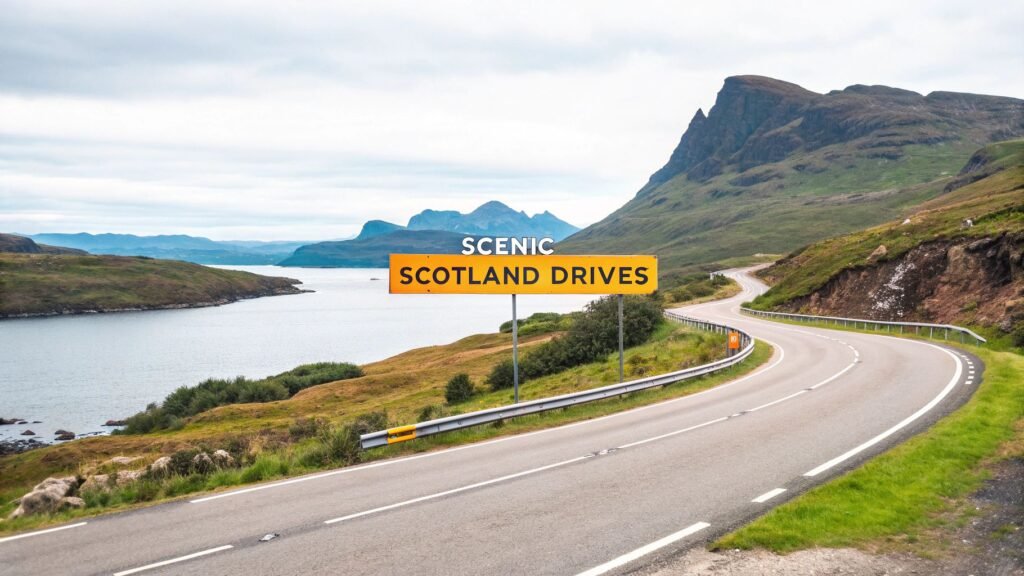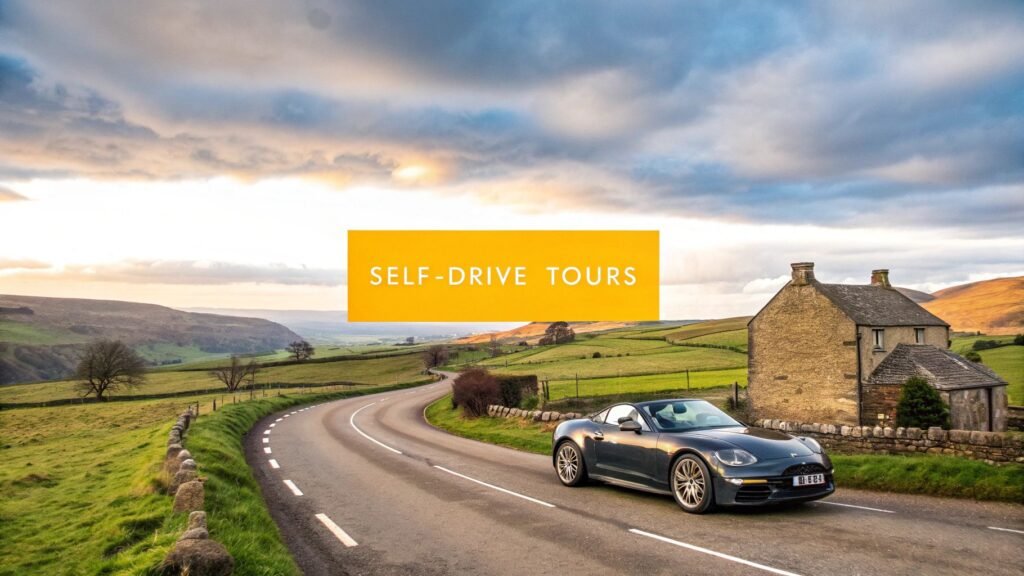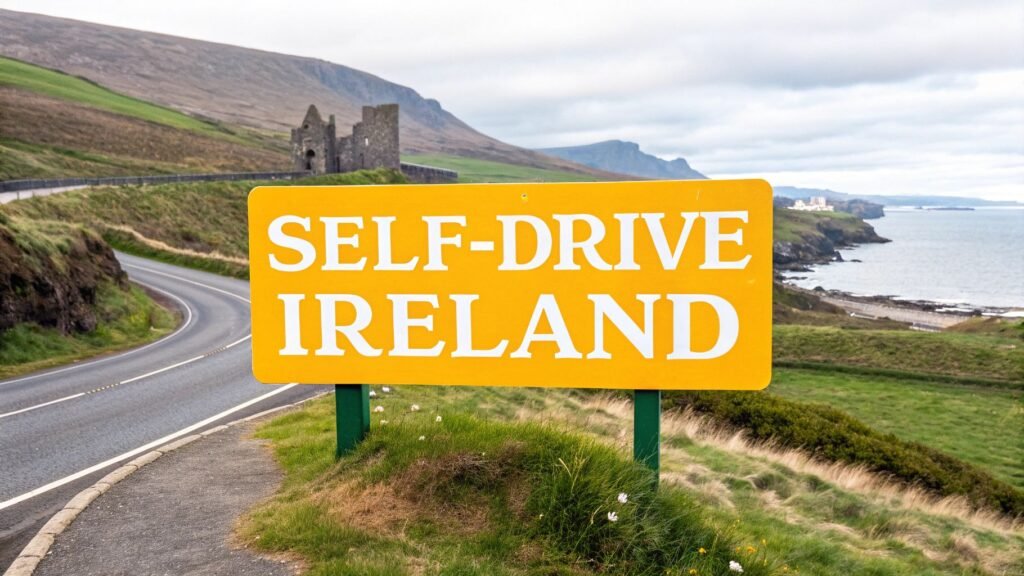Scotland's landscapes are the stuff of legend, a tapestry of rugged mountains, mirror-like lochs, and dramatic coastlines that have inspired poets and adventurers for centuries. While the iconic castles and vibrant cities are major draws, the true heart of Scotland is often found on the open road. Experiencing the country from behind the wheel offers unparalleled freedom to discover hidden glens, charming villages, and breathtaking viewpoints at your own pace.
This guide details seven of the most spectacular scenic Scotland drives, each offering a unique journey through the nation's diverse history and natural beauty. From the epic scale of the North Coast 500 to the tranquil, rolling hills of the Borders Historic Route, we have curated a collection of road trips designed for cultural explorers, nature lovers, and independent travellers alike.
Forget generic itineraries. Here, you will find practical, actionable advice tailored to each route, covering essential stops, driving considerations, and insider tips to help you maximise your time. Whether you're seeking the wild solitude of the Highlands or the gentle landscapes of the south, this list provides the framework you need to plan a truly unforgettable self-drive holiday. Prepare to embark on an adventure where every mile is as memorable as the destination.
1. North Coast 500
Often hailed as Scotland's ultimate road trip, the North Coast 500 (NC500) is a spectacular 516-mile circular route that begins and ends at Inverness Castle. This journey isn't just a drive; it's an immersive exploration of the Scottish Highlands, showcasing a breathtaking tapestry of rugged mountains, dramatic coastlines, and ancient history. Following the main roads along the coastal edges of the North Highlands, it has quickly become one of the most iconic scenic Scotland drives.
The route guides travellers through diverse regions, from the mystical Black Isle to the wild, untamed landscapes of Caithness and Sutherland on the far north coast. It then sweeps down the dramatic west coast, offering views of the Atlantic, remote lochs, and pristine white-sand beaches like Achmelvich and Clachtoll, which could easily be mistaken for the Caribbean on a sunny day.
Highlights and Itinerary Tips
While the entire route is magnificent, certain highlights deserve special attention. Be sure to visit the fairytale-like Dunrobin Castle, explore the mysterious Smoo Cave, and take a detour to the iconic John o' Groats signpost. For nature lovers, the potential for wildlife spotting is immense, from red deer in the glens to puffins and seals along the coast.
To make the most of this incredible journey, here are some key planning considerations summarised for quick reference.
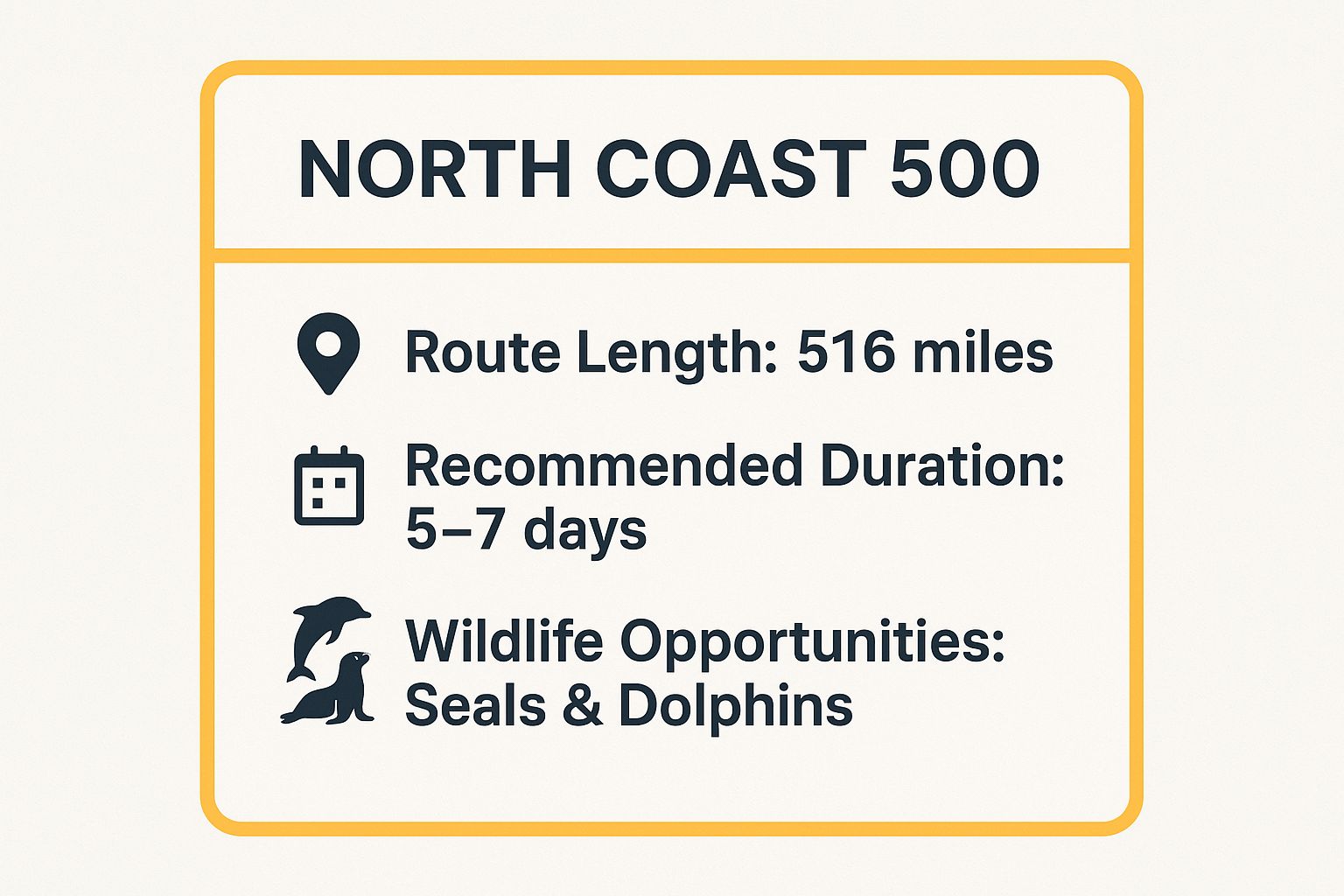
These key stats highlight that the NC500 is a significant commitment, requiring at least a week to properly enjoy the sights and wildlife without feeling rushed.
Practical Advice for Drivers
Navigating the NC500 requires some preparation, especially for those unfamiliar with Highland driving.
- Single-Track Roads: Much of the route, particularly on the west coast, consists of single-track roads with passing places. Familiarise yourself with the etiquette: pull into a passing place on your left to let oncoming traffic pass, or wait opposite a passing place on your right.
- Fuel and Supplies: Fuel stations can be sparse in remote areas. A good rule is to top up your tank whenever it reaches the halfway mark. The same logic applies to food and supplies.
- Accommodation: Due to its immense popularity, booking accommodation well in advance is essential, particularly between May and September. Campsites, B&Bs, and hotels can be fully booked months ahead.
- Direction: While the route is circular, travelling clockwise often provides passengers with better coastal views and can make navigating some of the trickier coastal sections slightly easier.
2. The West Highland Way Scenic Route
While the West Highland Way is a world-famous walking trail, much of its staggering beauty can be experienced by car on a parallel scenic drive. This route, primarily following the A82, is a journey through the very heart of the Scottish Highlands, offering a concentrated dose of iconic landscapes. It takes you from the serene "bonnie banks" of Loch Lomond, through the vast, moody expanse of Rannoch Moor, and into the awe-inspiring, mountainous theatre of Glencoe, before finishing in Fort William, a town nestled in the shadow of Britain's highest peak, Ben Nevis.
This drive is one of the most accessible yet dramatic scenic Scotland drives, plunging travellers directly into landscapes steeped in clan history and famed for their appearances in blockbuster films. The transition from the gentle Lowlands to the rugged Highlands is palpable, making it an unforgettable introduction to Scotland's wilder side. It’s a route that perfectly balances accessibility with a profound sense of scale and history, showcasing why this region has captivated artists, writers, and filmmakers for centuries.
Highlights and Itinerary Tips
Every turn on this route reveals a new vista, but some spots demand a longer pause. A stop at the historic Glencoe Visitor Centre is essential to understand the tragic massacre that haunts the glen. Further along, the Rest and Be Thankful viewpoint offers a breathtaking panorama, while a detour to Inveraray Castle provides a glimpse into ducal grandeur. The picturesque conservation village of Luss, on the shores of Loch Lomond, is another charming highlight.
To fully appreciate this classic Highland journey, consider these key planning points.
- Detour for the Viaduct: Allow extra time for the popular side trip to the Glenfinnan Viaduct, especially if you want to see the Jacobite steam train cross it.
- Autumn Colours: Visiting in autumn rewards you with a spectacular display of reds, golds, and oranges across the landscape, making for stunning photographs.
- Embrace the Weather: Glencoe's atmosphere is often enhanced by mist and rain. Check the forecast, but don't be deterred by imperfect weather; it's part of the authentic Highland experience.
- Picnic Potential: Pack a lunch to enjoy at one of the many designated picnic spots with incredible views, such as those overlooking Loch Tulla or the Three Sisters of Glencoe.
Practical Advice for Drivers
While the A82 is a major trunk road, it still requires careful attention, particularly during peak tourist season.
- Traffic Volume: The A82 is the main route to the western Highlands and can get very busy, especially in summer. Start your day early to avoid the worst of the traffic and secure parking at popular viewpoints.
- Road Conditions: The road is well-maintained but can be narrow and winding in sections, especially around Loch Lomond. Be prepared for slow-moving traffic, including lorries and caravans.
- Mobile Signal: Mobile phone and data signals are notoriously patchy or non-existent in areas like Rannoch Moor and Glencoe. It is highly recommended to download maps for offline use before you set off.
- Stopping Safely: There are numerous lay-bys and designated car parks. Never stop on the main carriageway to take photos, as this is extremely dangerous on such a busy road. Use only the marked stopping places.
3. Isle of Skye Circuit
A journey around the Isle of Skye is like stepping into a mythical realm, where otherworldly landscapes and ancient legends converge. This circuit around Scotland's largest Inner Hebridean island offers one of the most concentrated and dramatic scenic Scotland drives imaginable. Renowned for its jagged Cuillin Mountains, ethereal Fairy Pools, and dramatic coastline, Skye delivers a magical and unforgettable road trip experience.
The route takes you through a landscape shaped by volcanic activity and ancient history, from the bustling harbour of Portree to the windswept Trotternish Peninsula. Every turn reveals a new vista, be it a dramatic sea cliff, a serene loch, or a historic castle telling tales of warring clans. The island’s unique geology and Gaelic heritage create a powerful atmosphere that has captivated artists, photographers, and travellers for centuries.
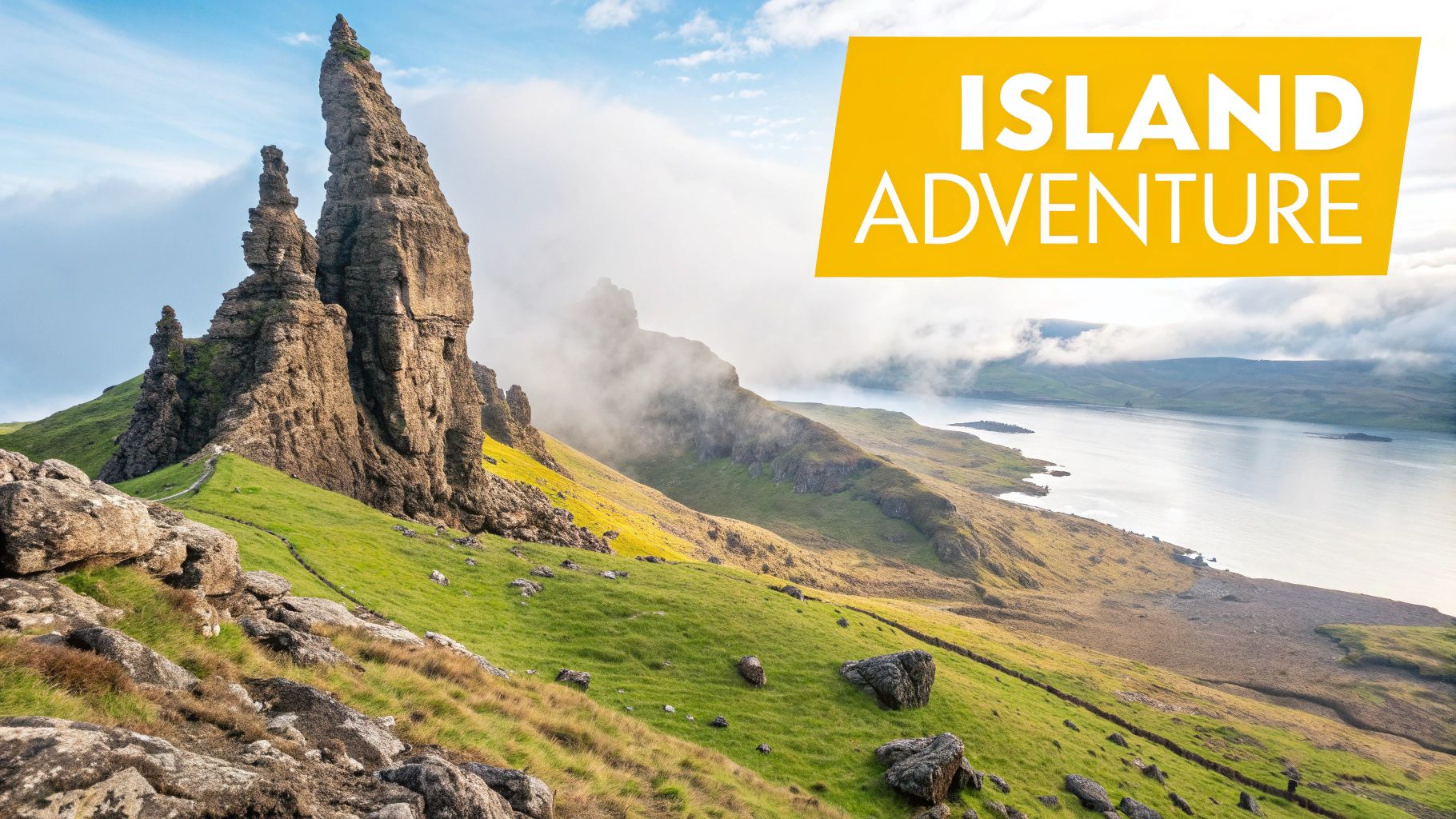
Highlights and Itinerary Tips
While the whole island feels like a highlight, certain spots are unmissable. Capture the iconic view of the Old Man of Storr, witness the Kilt Rock waterfall plunging into the sea, and explore the enchanting Fairy Glen. For a taste of local culture, visit the Talisker Distillery for a smoky single malt or explore the history of Clan Donald at Armadale Castle. For those interested in combining this visual feast with local flavours, you might enjoy a comprehensive self-drive tour that includes the island's culinary delights. Find out more about a self-drive culinary tour of Scotland.
To make the most of your Skye adventure, here are some key planning considerations.
- Duration: While you can drive the main loop in a day, allow a minimum of two to three days to truly explore the key sites and enjoy some short hikes without feeling rushed.
- Best Time to Visit: May, June, and September often provide the best balance of milder weather and fewer crowds compared to the peak summer months of July and August.
- Photography: For the best light and fewer people in your photos, visit popular locations like the Fairy Pools or the Quiraing very early in the morning or later in the evening.
Practical Advice for Drivers
Navigating Skye's popular routes requires planning, especially during the tourist season.
- Single-Track Roads: Many of Skye's most scenic roads, particularly those leading to the Fairy Pools or the Quiraing, are single-track. Use the designated passing places and allow faster vehicles to overtake.
- Accommodation: Skye's popularity means accommodation in places like Portree and Broadford gets booked up many months in advance. Secure your lodging as early as possible.
- Midges: From late spring to early autumn, midges can be a nuisance, especially at dawn and dusk. Pack a reliable midge repellent.
- Fuel: While there are fuel stations in the main villages like Portree and Broadford, it's wise to keep your tank topped up as you explore the more remote peninsulas.
4. The Snow Roads Scenic Route
For those seeking a journey through some of Scotland’s most dramatic and elevated landscapes, the Snow Roads Scenic Route is an unparalleled adventure. This 90-mile drive winds its way through the heart of the Cairngorms National Park, connecting the market town of Blairgowrie with the historic village of Grantown-on-Spey. True to its name, this is the highest public road in Britain, traversing wild, Alpine-like plateaus and offering scenery that feels a world away from anywhere else.
The route is defined by its steep climbs and descents, including the infamous Cairnwell Pass and the Lecht. It takes travellers through the eastern Cairngorms, a region renowned for its wide-open spaces, heather-clad moorlands, and resilient wildlife. This drive is less about the destination and more about the immersive experience of navigating a truly mountainous environment, making it one of the most memorable scenic Scotland drives.
Highlights and Itinerary Tips
The Snow Roads route is dotted with natural wonders, cultural sites, and unique viewpoints. Key stops include the Queen's View near Tarland for its breathtaking panoramic vistas, and Tomintoul, Britain's highest village. Whisky enthusiasts will appreciate a detour to the world-renowned Glenlivet Distillery to delve into the area's rich whisky heritage.
To fully appreciate this mountainous journey, consider these planning suggestions.
These statistics underscore that while the route is relatively short, its challenging terrain and numerous points of interest demand a slow and considered pace.
Practical Advice for Drivers
Driving the Snow Roads requires careful preparation, as conditions can change rapidly.
- Weather and Road Conditions: This is paramount. Always check the weather forecast and road status before setting off, especially outside of summer. The route is often subject to snow closures in winter.
- Vehicle and Supplies: Ensure your vehicle is in good condition. Fill up with fuel before you begin the main ascent, as stations are very limited. Carrying emergency supplies like warm clothing, water, and snacks is highly advisable year-round.
- Driving Style: The route features sharp bends, steep gradients, and single-track sections. Drive cautiously, use your gears for braking on descents, and be prepared to stop for wildlife, including red deer and mountain hares.
- Pacing: Do not rush this drive. Allow a full day to complete the 90 miles, giving you plenty of time for photo stops, short walks, and appreciating the sheer scale of the landscape.
5. Argyll Coastal Route
Stretching for 129 miles through the heart of ancient Dalriada, the Argyll Coastal Route is a journey through Scotland's magnificent maritime history. This drive, from Tarbet on the banks of Loch Lomond to Fort William, weaves through a landscape defined by glittering sea lochs, rugged peninsulas, and a deep connection to the isles. It offers a captivating blend of Highland scenery and coastal charm, making it one of the most rewarding scenic Scotland drives for those seeking history, seafood, and island adventures.
The route guides you along the shores of Loch Fyne, through historic towns, and past countless castles that tell the story of Scotland's powerful clans. It's a gateway to the islands of the Inner Hebrides, with the bustling port of Oban providing ferry connections to Mull, Iona, and beyond. This drive isn't just about the mainland; it’s an invitation to explore the unique culture and landscapes of Scotland's western isles.
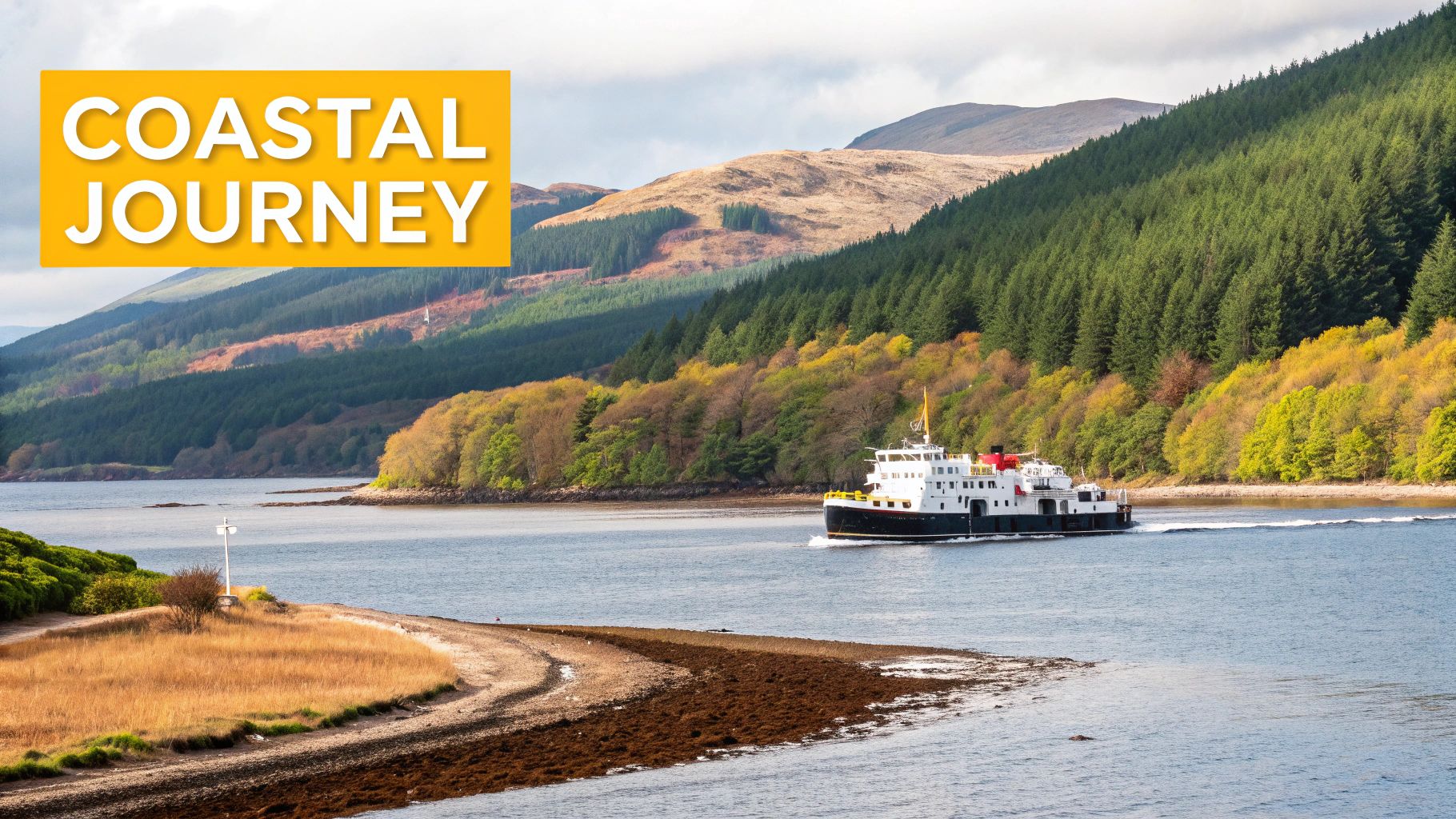
Highlights and Itinerary Tips
The Argyll Coastal Route is packed with cultural and natural treasures. Don't miss the striking Inveraray Castle, ancestral home of the Duke of Argyll, or the peaceful waterway of the Crinan Canal, often called 'Britain's most beautiful shortcut'. Oban, the 'Gateway to the Isles', is a must-visit for its lively harbour and exceptional seafood.
To truly immerse yourself in this region's character, consider the following suggestions.
- Inveraray Castle: Explore the magnificent home of the Clan Campbell and its beautiful gardens.
- Kilmartin Glen: Discover one of Scotland's most important prehistoric landscapes, with standing stones, stone circles, and burial cairns.
- Oban Distillery: Take a tour and sample a classic West Highland single malt.
- Island Hopping: Use Oban as a base to take a ferry to the Isle of Mull or the sacred Isle of Iona for a day trip. You can discover more about an Argyll Coastal Route journey here.
Practical Advice for Drivers
Driving the Argyll Coastal Route is generally straightforward, but a few tips will help ensure a smooth journey.
- Ferry Bookings: If you plan to take your car to any of the islands, booking your CalMac ferry well in advance is essential, especially during peak season. Passenger-only tickets are usually easier to get.
- Local Seafood: This is Scotland's seafood coast. Make time to stop at local restaurants and shacks, particularly around Loch Fyne for its world-famous oysters.
- Weather: The west coast weather can be very changeable. Pack waterproofs and layers, even in summer, and be prepared for plans to shift due to weather-related ferry disruptions.
- Allow Extra Time: While the route can be driven in a day, allow at least three to five days to properly explore the castles, glens, and islands without feeling rushed.
6. The Borders Historic Route
Venturing away from the dramatic Highlands, the Borders Historic Route offers a journey through a land steeped in history, literature, and quiet pastoral beauty. This 89-mile drive winds from the English border near Carlisle up to Edinburgh, showcasing the rolling hills, gentle river valleys, and rich heritage of the Scottish Borders. This area was once the heart of clan warfare and cross-border raids, but today it presents one of Scotland’s most peaceful and culturally significant scenic drives.
The route is a gateway to the romanticised Scotland popularised by Sir Walter Scott, whose former home, Abbotsford, is a key attraction. It guides travellers through a landscape dotted with the magnificent ruins of medieval abbeys, imposing stately homes, and charming market towns. Unlike the wild remoteness of other routes, this drive combines serene countryside with deep cultural immersion, making it a truly distinctive Scottish road trip experience.
Highlights and Itinerary Tips
This route is less about dramatic peaks and more about historical depth and tranquil landscapes. Key sites include the four great Border Abbeys: Melrose, where Robert the Bruce's heart is said to be buried, Jedburgh, Dryburgh, and Kelso. You can also visit Floors Castle, Scotland’s largest inhabited castle, and the ancient Traquair House.
To truly capture the spirit of the Borders, consider these suggestions for a more enriching journey.
This drive is a perfect complement to a city break, and you can learn more about the route's final destination, Edinburgh.
Practical Advice for Drivers
The Borders Historic Route is generally straightforward, but a few tips will help you make the most of it.
- Pacing the Drive: While the route can be driven in a day, allow at least two to three days to properly explore the abbeys, castles, and literary sites without rushing.
- Cultural Events: Check local schedules for Common Ridings festivals (summer) or the traditional Border Games held in towns like St Boswells. These events offer a fantastic, authentic insight into local culture.
- Local Produce: The Borders has a rich culinary heritage. Be sure to stop at local bakeries to try Border tart and tablet, or visit farm shops for local cheeses and meats.
- Literary Trails: For fans of Sir Walter Scott, dedicated walking and driving trails focus on his life and work. Incorporating one of these into your itinerary adds another layer to the experience.
7. Galloway Forest Dark Sky Route
For a truly unique driving experience that combines daytime natural beauty with nocturnal wonder, the Galloway Forest Dark Sky Route offers something entirely different. This journey takes you through Galloway Forest Park, the UK's first designated Dark Sky Park, where ancient woodlands, serene lochs, and rugged hills create a peaceful backdrop for one of the most remarkable scenic Scotland drives.
The route winds through the heart of Dumfries and Galloway, an often-overlooked corner of Scotland boasting dramatic landscapes and a tranquil atmosphere. By day, you can explore the 300 square miles of forest, home to red deer and golden eagles. By night, the near-total absence of light pollution reveals a breathtaking celestial display, with thousands of stars, planets, and the Milky Way often visible to the naked eye.
Highlights and Itinerary Tips
This route is as much about what you see after sunset as it is about the daylight drive. Key highlights include the Scottish Dark Sky Observatory, which offers public stargazing sessions with powerful telescopes. A drive or hike up to Merrick, Southern Scotland's highest peak, provides stunning panoramic views, while a stop at Clatteringshaws Loch offers accessible walking trails and a visitor centre. Don’t miss the medieval ruins of Threave Castle on its island in the River Dee.
To make the most of this astronomical adventure, consider these planning tips to enhance your journey through this protected dark sky landscape.
Practical Advice for Drivers
Driving in and around a Dark Sky Park presents its own unique set of considerations, especially when your goal is to enjoy the night sky.
- Stargazing Prep: Plan your visit around a new moon for the darkest skies. Check the weather forecast for clear nights, as cloud cover can obscure the view. Bring a red torch to help preserve your night vision when moving around in the dark.
- Driving at Night: The roads within the park are unlit to minimise light pollution. Drive cautiously and be aware of wildlife, especially deer, which can cross the road without warning. Especially for routes like the Galloway Forest Dark Sky Route, where darkness is part of the experience, consulting a night driving glasses guide can enhance your journey and safety.
- Connectivity: Mobile phone signal is unreliable or non-existent in many parts of the forest park. Download offline maps and route information before you set off.
- Day and Night Gear: Pack for all conditions. Waterproof clothing and sturdy walking boots are essential for exploring the forest trails by day, while warm layers, hats, and gloves are crucial for comfortable stargazing on a cold, clear night.
Scenic Scotland Drives Comparison Table
| Scenic Route | Implementation Complexity | Resource Requirements | Expected Outcomes | Ideal Use Cases | Key Advantages |
|---|---|---|---|---|---|
| North Coast 500 | Moderate – single-track roads | Medium – fuel, accommodation, time (5-7 days) | Immersive Highland coastal and cultural experience | Multi-day touring, wildlife viewing | Well-marked, diverse scenery, rich history |
| West Highland Way Scenic Route | Low – well-maintained A-roads | Low-Medium – good facilities, flexible time (1-3 days) | Accessible Highland landscapes with historic and cinematic appeal | Short to medium trips, family-friendly | Excellent road quality, historical sites |
| Isle of Skye Circuit | Moderate – single-track, island roads | Medium – accommodation can be limited/expensive, 2-3 days | Compact island exploration with dramatic landscapes | Island circuit tours, photography, cultural immersion | Diverse landscapes, strong cultural flavor |
| The Snow Roads Scenic Route | Moderate – high altitude mountain roads | Medium – careful planning for weather and supplies | Mountain driving experience with wildlife and seasonal appeal | Wildlife spotting, skiing, hiking combined tours | Spectacular alpine scenery, less crowded |
| Argyll Coastal Route | Moderate – includes ferry crossings | Medium – ferry scheduling, vehicle booking, 3-7 days | Coastal and island journey with maritime heritage | Island hopping, seafood and family-friendly trips | Diverse coastal scenery, seafood, island access |
| The Borders Historic Route | Low – good roads, easy driving | Low – short duration, standard facilities | Historical and pastoral landscape exploration | Cultural heritage tours, peaceful countryside | Rich history, less crowded, excellent local food |
| Galloway Forest Dark Sky Route | Moderate – forest roads, remote | Low-Medium – fewer facilities, nighttime planning | Stargazing and peaceful natural immersion | Astronomy enthusiasts, outdoor activities | Unique dark sky conditions, quiet and uncrowded |
Your Scottish Adventure Starts Here
Our journey through Scotland's most captivating driving routes reveals a country of staggering diversity and profound beauty. We've explored the epic, winding coastline of the North Coast 500, climbed through the dramatic Cairngorms on the Snow Roads, and delved into the rich tapestry of history along the Borders Historic Route. Each of these journeys offers more than just a path from A to B; they are immersive experiences that connect you directly with the heart and soul of Scotland.
The true magic of embarking on one of these scenic scotland drives is the freedom it affords. It’s the ability to pull over at a moment's notice to photograph a majestic stag, to detour down a single-track road that promises a hidden waterfall, or to spend an extra hour in a cosy village pub listening to local stories. From the ethereal landscapes of the Isle of Skye Circuit to the tranquil, star-dusted skies above the Galloway Forest, the common thread is the personal adventure you craft along the way.
Key Takeaways for Your Road Trip
To transform a good drive into an unforgettable one, remember these core principles:
- Plan, but remain flexible: Having a framework for your itinerary is crucial, especially for booking accommodation in popular areas like Skye or the NC500. However, the most cherished memories often come from unplanned stops. Build buffer time into your schedule to allow for spontaneity.
- Embrace single-track roads: These narrow roads are a quintessential part of the Scottish driving experience, particularly in the Highlands and Islands. Approach them with patience, use passing places correctly, and always offer a friendly wave to drivers who pull over for you. It's part of the local driving etiquette.
- Book accommodation in advance: During peak season (May to September), desirable B&Bs, hotels, and self-catering cottages on routes like the West Highland Way can be booked up months ahead. Securing your accommodation early removes a significant layer of travel stress.
- Prepare for all seasons in one day: The Scottish weather is notoriously unpredictable. Pack layers, waterproofs, and sturdy footwear, regardless of the forecast. A misty morning can easily transform into a brilliantly sunny afternoon, and you'll want to be ready to enjoy it.
Ultimately, the best scenic Scotland drives are the ones that resonate with your personal interests. Whether you are a history enthusiast tracing the steps of kings, a nature aficionado seeking remote wilderness, or a family looking for a memorable holiday, there is a road in Scotland waiting for you. The journey is yours to define, with every mile revealing a new vista, a fresh perspective, and a deeper appreciation for this incredible country. The open road is calling; it's time to answer.
Ready to experience these incredible landscapes without the stress of arranging every detail? BTOURS specialises in creating bespoke Scottish self-drive itineraries, combining the freedom you crave with the comfort of pre-booked, high-quality accommodations and expert local knowledge. Let us handle the logistics so you can focus on making memories on your dream Scottish road trip.

